Eisenach
![]()
This article is about the town in Thuringia; for other meanings, see Eisenach (disambiguation).
Eisenach is the sixth largest city in Thuringia and is located in the west of Thuringia. It is one of the so-called Luther cities. Since 1998 and until 1 July 2021, Eisenach has been an independent city and the centre of western Thuringia and the neighbouring areas of north-eastern Hesse. In regional planning, the city occupies the position of a medium-sized center with partial functions of a major center and is assigned to the planning region of Southwest Thuringia. Eisenach is located on the Hörsel River on the northern edge of the Thuringian Forest.
Eisenach is known for the Wartburg Castle above the city, which is a UNESCO World Heritage Site and was the seat of the Landgraves of Thuringia in the Middle Ages. It was there that Martin Luther translated the New Testament from Greek into German in the autumn of 1521. In 1817, the Wartburg Festival took place there, one of the most important events of the Vormärz. Since February 2017 Eisenach has been a university town, unofficially the town has the nickname Wartburgstadt.
In 1685 the composer Johann Sebastian Bach was born in Eisenach.
In the second half of the 19th century, industrialization began in Eisenach. In 1896, for example, the Fahrzeugfabrik Eisenach was founded, which belonged to BMW from 1928 and later built the Wartburg as the Automobilwerk Eisenach. The tradition of automobile manufacturing was continued after 1990 by Adam Opel AG. Today, the factories of the automotive industry such as Opel and Bosch employ more than 4000 people, which makes Eisenach an industrial centre of Thuringia.
On July 1, 2021, Eisenach will lose its county status again and be incorporated into the Wartburgkreis.

Karlsplatz is the central square of the city
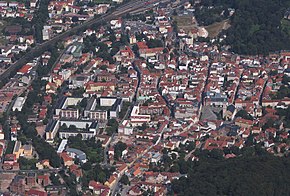
Aerial view of the old town of Eisenach
Geography
The core city of Eisenach lies in the valley of the Hörsel, which flows into the Werra on the right side in the district of Hörschel. The lowest point of the entire city area is not far north of the district of Hörschel at about 196 m above sea level in the Werra valley. The lowest point of Eisenach's old town is at the former Nadeltor on Goethestraße.
In the south and southwest, the Thuringian Forest rises steeply to heights of over 400 m above sea level. There, the Rennsteig between the Hohe Sonne and the Vachaer Stein forms the southern border of the urban area. At 460 m above sea level, a rocky hilltop on the Weinstraße at the Kleiner Drachenstein is the highest point in Eisenach's urban area. Between the Hohe Sonne and the city are the Drachenschlucht and the Landgrafenschlucht. The cursed Jungfernloch, a rock cave, is located in the mountains of the southern part of the city, as are the Burschenschaftsdenkmal and the Wartburg. Also south of the town area, the Bundesstraße 84 crosses the Rennsteig at the Vachaer Stein, the pass is at 368 m above sea level.
To the east of Eisenach stretches the Hörsel valley and the Hörsel mountains bordering it to the north, which according to legend are the home of Frau Holle. North of the Hörselberge runs the valley of the Nesse, which flows into the Hörsel at Eisenach's Petersberg.
North of Eisenach an extensive plateau extends to the edge of the Hainich with the Eisenach districts of Hötzelsroda, Neukirchen, Madelungen and Berteroda.
West of Eisenach, at Stedtfeld, the Hörsel valley narrows to a width of a few hundred metres. At the Thuringian Gate near Hörschel, the Hörsel flows into the Werra and there begins the Rennsteig as a ridge trail of the Thuringian Forest; the districts of Göringen, Wartha and Neuenhof lie south of the Rennsteig in the Werratal.
Nature area
Due to its location on the border of two natural areas, Eisenach is one of the so-called gateway towns. It mediates between the Werrabergland and the Hörselberge, two stratified landscapes shaped by the shell limestone in the north and the northwestern Thuringian Forest shaped by the sandstones and conglomerates of the Oberrotliegende in the south. In the northwest, the urban area of Eisenach has a share in the Gerstungen-Creuzburg Werra floodplain. The edge mountains of the Thuringian Forest south of the Neuenhof district are located in the north of the Bad Liebenstein Zechstein belt. This location on the edge of several natural areas favoured the development of the medieval town of Eisenach as a market for the raw materials wood and rocks and the products derived from them as well as for agricultural products. The location on an important pass road over the Thuringian Forest was also favourable for the town's development.
Neighboring communities
The municipalities of Krauthausen and Creuzburg border the town to the north. To the east of the town follow the municipalities of Hörselberg-Hainich and Wutha-Farnroda. They are followed to the southeast by the town of Ruhla and to the south and southwest by the municipality of Gerstungen. While all these neighbouring municipalities lie in the Wartburgkreis district of Thuringia, the urban area borders on Herleshausen in the Werra-Meißner district of Hesse to the west.
Extent and structure of the urban area
The Eisenach city area covers an area of 103.85 km². Of this, 7.44 km² are built-up areas, 6.10 km² are traffic areas, 45.39 km² are agricultural areas and 1.12 km² are commercial and industrial areas. Due to the location at the Thuringian Forest, the forest areas with 37.52 km² take up about one third of the city area.
Eisenach consists of the core city and the districts of Berteroda, Hötzelsroda, Madelungen, Neuenhof, Hörschel, Neukirchen, Stedtfeld, Stockhausen, Stregda, Wartha and Göringen.
The districts have district constitutions, Neuenhof and Hörschel as well as Wartha and Göringen each have a joint district constitution.
See also: List of the districts of Eisenach
Climate
The precipitation totals are between 781 and 959 mm per year, the mean value is 831 mm (state average: 837 mm). In most of the urban area, the values are between 800 and 850 mm, only in the floodplains of the Werra and Hörsel rivers do the values fall below 800 mm. With 850 to 900 mm per year, the highest precipitation amounts are reached in the north and south of the urban area.
The annual average temperature of the city is 7.6 to 9.0 °C and thus corresponds to the Thuringian state average. The annual average of sunshine duration is 1423 to 1444 hours per year. The predominant wind direction in open areas is west-southwest.
| Monthly average temperatures and precipitation for Eisenach
Source: Climate-data.org | |||||||||||||||||||||||||||||||||||||||||||||||||||||||||||||||||||||||||||||||||||||||||||||||||||||||||||||||||||||||||||||||||||||||||||||||||||||||||||||||||||||||||||||||||
Nature Conservation
The city area is part of the Thuringian Forest landscape conservation area and the Thuringian Forest Nature Park. In the northwestern part it touches the nature park Eichsfeld-Hainich-Werratal. Large parts of the nature reserve forests with ravines between Wartburg and Hohe Sonne are located in the south of the urban area between the outskirts of the city and the Rennsteig. There are the extensive mixed deciduous forests and significant geotopes typical of the Northwest Thuringian Forest natural area.
See also: List of nature reserves in the city of Eisenach
Among 15 protected landscape elements, area natural monuments and natural monuments, there are two bat roosts of regional or national importance.
| Protected object | Year of protection | Brief description |
| Basalt passage in the Lower Muschelkalk at Hörschel railway station | 1977 | Geological outcrop |
| Neuenhof bat roost | 1988 | Bat roost of nationwide importance |
| Donnerkaute near Neuenhof | 1988 | Earthfall |
| Reefs of the Upper Zechstein near Neuenhof | 1988 | Geological outcrop |
| Wetland in the Mosewald | 1985 | Wetland |
| Bat roost in Stedtfeld Castle | 1988 | Bat roost of regional importance |
| Zechstein outcrop at the Göpelskuppe | 1977 | Geological outcrop |
| Michelskuppe | 1966 | Geological outcrop |
| Rotliegend at the Wartburg loop | 1977 | Geological outcrop |
| Elf Grotto | 1966 | Rock formation |
| Relay fracture in the Rotliegend at the end of the town (B 84) Eisenach | 1977 | Geological outcrop |
| Luisengrotte | 1966 | Geological outcrop |
| Ludwigsklamm | 1966 | Rock formation |
| Landgrafenschlucht | 1966 | Rock formation |
| Dragon Gulch | 1977 | Klamm |
Geology, geomorphology
The city area's share of the northwestern Thuringian Forest is formed in the near-surface geological subsurface by the Eisenach sequence of the Oberrotliegend (Saxon). The strata of the Wartburg conglomerate in the east are followed in the west by unconformable siltstones, the so-called schist clays, and the gravelly sequence of the main conglomerate. The eroding streams cut the silicate-bound and thus hard conglomerates and sandstones like gorges and prepared the numerous high rock bands which, like the gorges, are characteristic of the landscape. Larger gorges are the Drachenschlucht and the Landgrafenschlucht. Significant rocks are located below the Wartburg, at the Teufelskanzel and at the Mädelstein.
The northern slopes of the Hörsel valley and the stratified areas to the north are characterised by the stratified rocks of the middle and upper Muschelkalk and the lower Keuper. The stratified areas can also be covered by loess loam. In the area of Eisenach, the geological strata of the Werrabergland are divided into several strata packages by several Hercynian-striking faults. Along the fault edges the geological strata are mostly tilted against each other. A layer rib of shell limestone, for example, forms the up to 20-metre-high cliffs of the Michelskuppe within the northern city area. On the fault lines southwest of the Stregda district and around the Eisenach cemetery, clay and marl stones of the lower Jurassic have also come to light over large areas. The far west of the urban area is characterised by the Leine sequence and the Werra-bis-Staßfurt sequence of the Zechstein. Limestone and dolomite dominate there, but also anhydrite and gypsum. The copper slate bank and reef limestones are exposed, for example, at the Burschenschaftsdenkmal. An outcrop with rocks from the Tertiary period has been preserved in a so-called geological window at Hörschel railway station. It is a basalt passage in the Hörschelberg, which was formed at the time of the Rhön volcanism. The floodplains of the Hörsel and Werra rivers are filled with alluvial sediments, mostly loose valley sands, which were deposited there by the rivers in the recent geological past. They are the largest levees in Eisenach's urban area and are important as industrial sites. The old town of Eisenach was built on periglacial weathering debris, i.e. debris formed during the Weichselian period, on the northern edge of the Thuringian Forest.
Flora and vegetation
The potential natural vegetation at almost all sites in the Eisenach urban area are red beech forests. The spectrum ranges from limestone and orchid beech forests to Hainsimsen beech forests on the Rotliegend conglomerates of the northwestern Thuringian Forest. Alder-ash stream forests and willow-ash floodplain forests have naturally developed in the floodplains. The natural vegetation of the gorges consists of maple-ash gorge forests. In extreme locations on cliff tops and ridges over conglomerate and sandstone, dry oak woodlands may have developed. On steep south-facing slopes, for example on Petersberg in the east of the city, the steepness and dryness of the sites make it difficult for the trees to grow up. In places there are species-rich dry shrubs and grasslands. Sloes and hawthorn species are common, but rarer species such as barberry, privet, buckthorn and juniper are also present. There is also an endemic species on the slopes of the Petersberg, the Eisenacher Mehlbeere. The shell limestone slopes on the Petersberg are mostly dominated by the knotty grass lily.
The current vegetation differs significantly from the potential natural vegetation in many places. The forests have been overgrown by forestry. Non-natural tree species such as Norway spruce, Scots pine and black pine have been introduced or used for the reforestation of eroded slopes. Large areas, especially in the north and east of the urban area, are subject to intensive agricultural use and are dominated by cultivated plants. At best, plant species of the arable flora such as corn poppy or odourless camomile can gain a foothold there in places. In the area of the former military training area on the Wartenberg in the north of the urban area, extensive, semi-natural species-rich rough grasslands (trespen grasslands) have been created through sheep grazing. In places, gentian-schiller grass lawn can also be found there. The forests in the Thuringian Forest landscape conservation area in the southern part of the town are particularly close to nature. They also contain floristic features such as the two-flowered violet. Beech and pedunculate oak are stand-forming there and reach their natural age in places. Old and particularly tall specimens of common ash and sycamore maple have grown in the numerous ravine and boulder forests. Extensive wetlands are located in the west of Eisenach between the Thuringian Forest and the automobile plant. There, reed beds, a lake, brooks, riparian forests, reed cane grass reeds, wet high herbaceous meadows and wet meadows are closely interwoven. Old trees, including several black alders, characterize the area, as does the transition to near-natural deciduous forests interspersed with rocks.
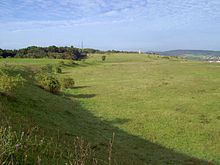
Trespen lawn at Wartenberg
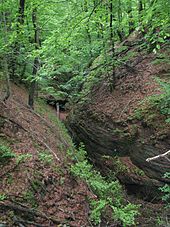
The Landgrafenschlucht near Eisenach with an outcrop of Rotliegend conglomerates

Overview districts

View from the Michelskuppe to the city centre of Eisenach, at the right edge of the picture the Inselsberg in the Thuringian Forest
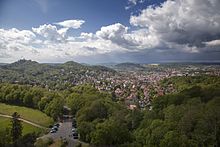
Panorama of Eisenach with the Wartburg, seen from the Burschenschaftsdenkmal on the Göpelskuppe
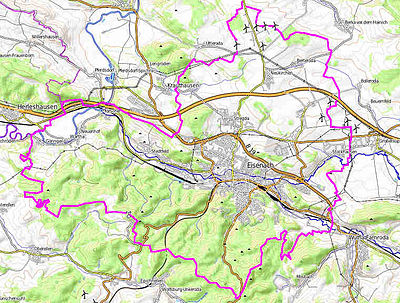
Topographic map of Eisenach - Source: OpenTopoMap (2013)
Culture and sights
Cultural institutions
The Eisenach Theatre was inaugurated in 1879 and, after an eventful history, was elevated to the status of Thuringian State Theatre Eisenach by the then Thuringian state government in 1952. An important part of the theatre is the Eisenach State Orchestra, which was founded in 1919 as the Municipal Orchestra. It was rebuilt after the end of the Second World War in 1946 with displaced members of the Silesian Philharmonic Orchestra in Wroclaw and musicians from the former Eisenach Municipal Orchestra, and was given its present name in 1952. In addition to the Landeskapelle, the Eisenach Dance Theatre has been part of the ensemble since 2004 and the Eisenach Young Theatre since 2005.
After the dissolution of the Theaterpädagogisches Zentrum at the Landestheater Eisenach, the Theater am Markt, founded in 2008, developed into a volunteer-run independent theater.
Exhibitions and concerts are regularly held in the historic Wandelhalle, which in 1906 facilitated Eisenach's rise to the status of spa town - an open music pavilion on the edge of the Kartausgarten, which was built as an English-style park at the beginning of the 20th century. In addition to an industrial museum, the industrial monument Alte Mälzerei houses a theatre venue and the Lippmann+Rau music archive, which until 2009 was looked after by the Jazzklub Eisenach e. V., founded in 1959.
Eisenach traditionally has a rich choral landscape; the Bach Choir Eisenach is one of the choirs that is also known beyond the region. The majority of the choirs in the city and the surrounding Wartburg district are organized in the Wartburgsängerkreis.
In the so-called Storchenturm, the historic theatre Im Kerker is the smallest venue in the city.
Eisenach has a cinema, the Capitol Filmtheater, which is a listed building and the last of the four former sound film cinemas in Eisenach.
Since 2007, contemporary art exhibitions have been held in the former exhibition pavilion of the Eisenach automobile plant, now the KUNSTPavillon, in Wartburgallee. The pavilion was built in 1967 and served as an exhibition space for motor vehicles built in Eisenach until 1994. It has been a listed building since 2013.
Events
Every year on the weekend before Laetare, one of the largest spring festivals in Germany takes place in Eisenach, the Sommergewinn. The highlight is the parade on Saturday, at the end of which Mrs. Sunna and Mr. Winter have the traditional argument.
During the Christmas season, the traditional Christmas market at Wartburg Castle and the Christmas market on Eisenach's market square with about 50 exhibitors are among the tourist attractions.
In the years 2005 to 2007, Luther - The Festival took place at the end of August in view of the Luther Decade 2008 to 2017. The Lutherverein e. V., the main organiser, is endeavouring to develop this event further as a medieval festival with new themes and offerings. Since 1982, the Eisenach Telemann Days have been held every two years in honour of the composer Georg Philipp Telemann. In spring, the city is one of the venues for the Thuringian Bach Weeks.
As a venue for jazz music, the Alte Mälzerei has been a household name since the 1990s, and open-air concerts are held at the Wandelhalle (Reggae Nights).
Since the reunification Eisenach has been the permanent meeting place of the Deutsche Burschenschaft. The Burschentag always takes place in the week after Whitsun.
The Motorsportclub Eisenach e. V. is the organiser of the Wartburg Rally, a road race around the city of Eisenach, which takes place every summer. For classic car fans, Thuringia tours and veteran meetings are held regularly in spring and summer.
Castles and palaces
The landmark of the city is the world cultural heritage Wartburg.
In addition, there were numerous castle complexes on the mountains surrounding the old town, which are only remembered by field names and sparse remains as ground monuments, in particular the Metilstein, the Eisenach Castle, the Frauenburg, the castle site Rudolfstein and the Malittenburg. Within the walls of the old town there were aristocratic town castles, including what is probably the oldest professional building in the town, known as the Hellgrevenhof, and the Lussenhof on the Frauenberg. The landgravial Steinhof as the town residence directly south of the Georgenkirche was followed on the same site by the ducal residence castle, of which the castle brewery, the well cellar, the residence house and the Creutznacher Haus still exist. The former Klemme moated castle served as a fortress and later as a garrison.
The preserved castles and castle-like buildings in the core city include the Eisenach City Palace, Fischbach Palace, Bechtolsheim Palace, Pflugensberg Country House and Hohe Sonne Hunting Lodge, which is in urgent need of renovation. In the districts of the town are Berteroda Castle, Neuenhof Castle, and in Stedtfeld the Boyneburg Lower Castle, small remains of the Upper Castle, the Steinstock fortified tower and a Boyneburg country villa. The Stedtfeld moated castle was razed after the Thirty Years' War. The buildings of the moated castle in Madelungen with the associated estate have also disappeared. In Hötzelsroda there was an earthwork called a redoubt, an aristocratic estate called Schlösschen in the village and in the district of Dürrerhof the manor house Dürrerhof with landscape park, which was demolished in the 1950s.
Sacred buildings
→ Main article: List of sacral buildings in Eisenach and List of former sacral buildings in Eisenach.
Evangelical-Lutheran Churches
The Georgenkirche, built around 1180, is considered the wedding church of St. Elisabeth and is the baptismal church of Johann Sebastian Bach.
The Nikolai Church was built in Romanesque style shortly after 1160 and restored in neo-Romanesque style in the 19th century. The church was the parish church of the Benedictine monastery of St. Nikolai until the Reformation.
According to legend, the Annenkirche was built by Elisabeth of Thuringia as a house of prayer, the inscription above the archway "Hospital zu St. Annen - gestiftet von der Heiligen Elisabeth 1226" is supposed to prove this. In fact, the former chapel fell victim to a fire in 1342, and the new building was destroyed in 1525 during the Peasants' War. Between 1634 and 1639 the Annenkirche was completely rebuilt, and the inscription probably dates from that time. In the 18th century the church was used as a garrison church, from 1874 to 1954 as the church of the deaconesses' house foundation.
The Clemens Chapel was first mentioned in a document in 1295. The half-timbered church of Wartha, built in 1586, is the oldest and smallest half-timbered church in Thuringia.
The most recent church building is the Elia Chapel in the Altstadtstraße, which was completed in 2005. It serves as a place of prayer on the workshop premises of the Diakonie-Verbund Eisenach.
Catholic Churches
The parish church of the Catholic parish of St. Elisabeth Eisenach is the St. Elisabeth Church. It was built between 1886 and 1888 in the neo-Gothic style, modelled on the Elisabeth Church in Marburg. In the years 2000 to 2002 an extensive exterior and interior renovation took place.
Not far from the old cemetery is the profaned Kreuzkirche, which was built in 1692 from the remains of the Mariendom in Eisenach.
The Preacher's Church is located on the site of a former Dominican monastery. Its construction was begun shortly after the canonization of Elisabeth, and it was consecrated around 1240. Today the church houses the permanent exhibition Medieval Art in Thuringia, which is part of the Thuringian Museum.
Synagogue
Already in the Middle Ages there was a synagogue on the property Karlstraße 23. Between 1883 and 1885, the New Synagogue was built in today's Karl-Marx-Strasse and was solemnly consecrated on 8 January 1885. During the November pogroms of 1938, the building was completely destroyed by arson and demolished a short time later. The events are commemorated by the synagogue memorial, which was handed over on 21 September 1947 and whose base was built from stones from the New Synagogue.
Listed buildings
→ Main article: List of cultural monuments in Eisenach
Monument ensembles
The two largest monument ensembles in the city in terms of area are the area monument Old Town Eisenach and the area monument Southern Quarter.
The construction of the 2.84-kilometre-long city wall began as early as 1130. There were a total of 22 towers, five of which were city gates, of which only the Nikolaitor remains today.
Individual architectural monuments
Eisenach's town hall on the market square was built in 1508 in late Gothic style as a wine cellar and received its present Renaissance forms when it was rebuilt in 1564. In 1596 it was chosen as the new town hall after the old town hall near the Georgenkirche had become too small. After the great town fire in 1636 it was rebuilt and received its characteristic stair tower in 1638.
The Georgsbrunnen has stood on the market square for more than 450 years, and has been moved several times. The gilded fountain statue was created by Hans Leonhard in 1549. The town castle is also located on the market square. It was built in several sections from 1742 onwards by Gottfried Heinrich Krohne under Duke Ernst August. Of the once four wings, three are still preserved today. The south wing on the market square was built as a residential wing incorporating existing town houses, the north wing houses richly decorated rooms with stucco work by the Kassel master J. M. Brühl and paintings by the Austrian painter Josef Michael Daysinger, and the ground floor of the west wing houses the stables.
The building Karlstraße 1 was built around 1560. It remained intact during the town fire of 1636. From 1771 to 1948, the Hof-Apotheke, founded in 1585, was located here. In 1900, the old timber framework was exposed and a gable was erected above the entrance. Further alterations were made in 1936. The Hof-Apotheke was renamed the Rats-Apotheke in 1948 and is still located in the building today.
In the south of the city, not far from the driveway to Wartburg Castle, is the Reutervilla. It was built in neoclassical style by the German architect Ludwig Bohnstedt between 1866 and 1868 according to the plans of the poet Fritz Reuter. Today, the villa houses the Reuter-Wagner Museum as well as a branch of the registry office.
In the east of the city, the Burschenschaftsdenkmal of the Deutsche Burschenschaft (German fraternity) rises up on the Göpelskuppe. The 33 meter high monument was inaugurated in 1902.
The Eisenach Theatre was commissioned by the Eisenach banker and factory owner Julius von Eichel-Streiber and built in the classicist style according to designs by the Leipzig architect Karl Weichardt. It was handed over to the city of Eisenach on 1 January 1879. The building seats 501 spectators.
On Johannisplatz in the centre of the city is probably the narrowest inhabited half-timbered house in Germany. It is 2.05 meters wide and 8.50 meters high and has two floors. The age of the house is estimated to be well over 250 years.
In 1539, the Eisenach merchant and councillor Conrad Creutznacher built a representative residential and commercial building on the market square, the Creutznacher Haus. When Duke Johann Ernst extended his residence on the Esplanade at the end of the 16th century, he incorporated the house into the palace complex. The building, which was renovated between 2003 and 2005, is one of the few remaining Renaissance buildings in the city and today houses, among other things, the tourist information office.
The Sophienbad, one of the oldest Art Nouveau baths in Germany, was opened in 1899 by the Grand Duchess of Saxony-Weimar-Eisenach. Today it is used for other purposes, but is protected as a whole.
The Wandelhalle at the edge of the Kartausgarten was inaugurated in 1906, below the Hotel Fürstenhof, as a Trink- und Wandelhalle and is a reminder of the time when Eisenach was a summer resort and spa town.
The Deaconess House in the city centre and the south wing of the present St. George Clinic in the north of the city are listed witnesses to the health care system of the early 20th century.
· 
Creutznach House with Old Residence
· 
Fraternity Monument
· 
Jakobsplan with Panzerreiter and Palais Bechtolsheim
· 
Pflugensberg country house
Parks
The history of the Kartausgarten, which covers about 3.8 hectares, dates back to the 14th century, when Carthusian monks laid out a monastery garden there around 1390. Around 1700 it was raised to the status of a princely pleasure and kitchen garden, and at the end of the 18th century Johann Georg Sckell transformed it into a landscape garden. From 1845 it was tended by the Eisenach court gardener Hermann Jäger. Since 1942 the garden has been in municipal hands. In addition to the classicist gardener's house with tea room, the grounds also include the Wandelhalle.
About 400 meters east of the city center is the 26.7 hectare city park. The grounds on the Goldberg were redesigned into a landscape garden from 1841 to 1844 by Eduard Petzold on behalf of the Eichel family. Between 1890 and 1892, the Pflugensberg villa, later used as the regional church office, was built there, a castle-like building in the neo-Gothic style. The Bismarck monument in the entrance area of the city park was demolished in 1963.
The Dürrerhof Landscape Park, also designed by Eduard Petzold, is located in the district of Hötzelsroda with the Hötzelsroda war gravesite, which was created after the Second World War.
Above the Eisenach market at the foot of the Schlossberg is the Old Cemetery. It was laid out in 1599 by order of Duke Johann Ernst. Numerous members of the Bach family of musicians are buried in the cemetery, and the adjacent Kreuzkirche houses the archives of the Evangelical Lutheran Church in Thuringia.
Between Wartburg Castle and the western part of the Old Town is the Roesesches Hölzchen landscape park with the Metilstein in the centre, created around 1800 by the Eisenach merchant Christian Friedrich Roese. Here you will also come across the legendary rock formation of the Monk and the Nun, which once inspired Goethe to a drawing.
In the Mariental is the artificially created Prinzenteich with gondola operation, swans and carp stocking. It received its name in the 19th century in honour of the two sons of the Duchess of Orleans, who temporarily stayed in Eisenach with her children between 1848 and 1858.
In the north of the city the main cemetery was established in 1896.
In the Dresdner Straße there is a geological garden with rock samples from all over Germany.
Museums
Eisenach is the birthplace of the composer Johann Sebastian Bach. The Bachhaus am Frauenplan, which is considered the composer's birthplace, is dedicated to him and his family.
The Luther House, which has been operated as a museum since 1956 by the then Thuringian Regional Church (today: Evangelical Church in Central Germany), commemorates the reformer Martin Luther. In the house, which is one of the oldest half-timbered houses in Thuringia, Martin Luther is said to have lived with the wealthy Cotta family from 1498 to 1501. From 2013 to 2015, the Luther House was extensively renovated, extended by an annex and equipped with a new permanent exhibition ("Luther and the Bible").
The city palace houses the Thuringian Museum, founded in 1899. This also includes the exhibition areas in the Predigerkirche, the tea room in the Kartausgarten and the Reutervilla. The arts and crafts collection moved to the city palace in 1931. In addition to the collection of Thuringian porcelain, there are also works of painting from the second half of the 19th century and expressive realism, as well as works of city history. The Predigerkirche houses the collection of medieval carving art, the most extensive of its kind in Thuringia. In the Reutervilla, the former living quarters of the Low German poet Fritz Reuter, is the Reuter-Wagner Museum with the most extensive collection on the composer Richard Wagner after Bayreuth.
The Museum of Automobile Construction was founded in 1967. It was initially located in today's purpose-built KUNST pavilion on the edge of the Kartausgarten. In 1998, on the occasion of the 100th anniversary of automobile manufacturing in Eisenach, the symbolic foundation stone was laid for the new exhibition automobile welt eisenach on the site of the former Eisenach Automobile Works (AWE). Since 2005 the exhibition, which shows for example vehicles of the brands BMW, EMW, Dixi and Wartburg, is located in the listed former AWE administration building O2. In the immediate vicinity of this is the former main gate of the AWE, which is also a listed building.
The Goldener Löwe memorial, a former inn at the southern end of Marienstraße, commemorates the founding of the SDAP (later SPD) on 8 August 1869 and August Bebel.
Since June 2010 the administration building Rennbahn 6 of the Wartburg-Sparkasse houses the Sparkassen-Museum.
A non-public collection on Eisenach's criminal history with historical uniforms, technical equipment for surveillance by the Stasi, as well as evidence of agent activity in Eisenach during the Cold War is housed in the Eisenach police station.
Industrial monuments
In the north-east of the city, the Alte Mälzerei is a unique industrial monument. It was built in 1873 by Adam Heintz as a malt and malt coffee factory. Particularly remarkable is the almost completely preserved machinery, some of which dates back to the founding years and was fully functional again after restoration in 1993/1994.
The foundation stone for the Eisenach brewery was laid in 1828, when the 244 brewers in the town built a common rock cellar about 100 metres deep for storing beer. In 1874, ten Eisenach citizens founded an association brewery, which became the Eisenach Joint Stock Brewery in 1886. The brewhouse, built in 1911, is still considered the brewery's landmark today.
Around the turn of the 19th/20th century, Eisenach's main railway station was built with the Fürstenbahnhof to its right.
Eisenach's industrial buildings that are only partially preserved include the Old Slaughterhouse and the Eisenach Gasworks. The former cigar factory at Fischweide 1 was long preserved as a ruin and has since been demolished.
Monuments, memorial stones and plaques
→ Main article: List of works of art in public space in Eisenach
Numerous memorial stones and plaques commemorate historically significant events and personalities in the town's history.
In the immediate vicinity of the Bach House is the Bach Monument, which the city dedicated to the Eisenach-born composer on 28 September 1884. It was designed by Adolf von Donndorf and executed by Hermann Howaldt.
On Karlsplatz in the centre of the city is the Luther Monument, also designed by Adolf von Donndorf. A third monument designed by Donndorf, the Bismarck Monument erected in 1903 at the entrance to the city park, was removed by 1963.
In Georgenstrasse, the Black Fountain commemorates a tragic accident in which 68 people were killed when three wagons loaded with gunpowder and ammunition exploded.
In honour of the dead of the Franco-Prussian War of 1870/71, the Wingolf Association consecrated the Wingolf Monument in 1899, which was later also dedicated to the fallen of both world wars. It is integrated into an imposing staircase that leads from the city centre over the Pfarrberg into the southern quarter.
Opposite the Wartburg driveway, the Carl Alexander Monument was inaugurated in 1909 to commemorate the Grand Duke's friendship with Eduard Mittenzwey. It was executed by the Eisenach sculptor Hermann Hosaeus. Further along the road, below the Wartburg, one comes across the Cranach Monument to Hans Lucas von Cranach, the captain of the Wartburg and founder of the Reuter-Wagner Museum.
In Frankfurter Straße there is a memorial to the victims of the Kapp Putsch, which commemorates the killing of five unarmed citizens in Eisenach.
On Karlsplatz, in front of the motherhouse of the Eisenach Diaconia Foundation, stands the Doctors' Monument, a memorial created in 1926 for the German doctors who died in the line of duty during the First World War. It was restored in 1997 and the dedication extended to "...the (medical) victims of war, terror and tyranny".
A tank rider symbolizing St. George the dragon slayer stands at Jakobsplan. It was created in 1939 by Erich Windbichler and originally stood in front of the officers' mess of the barracks complex at Ludendorffwall (today: Ernst-Thälmann-Straße) in the north of the city. The monument stands for the tradition of the heavy Silesian horsemen from Sagan, the "predecessors" of the Eisenach tank regiment II. In 1999 the monument was restored.
A now listed relic of the GDR era is the monument to the history of the German workers' movement in Wartburgallee.
Several monuments, memorial stones and plaques commemorate the victims of the two World Wars as well as the crimes of the Third Reich and the Holocaust; these also include around 100 Stolpersteine (stumbling stones) as well as the memorial to the "De-Jewification Institute", which was unveiled in 2019.
The Bismarck tower of the type "Götterdämmerung", built in 1902 on the Wartenberg according to a design by Wilhelm Kreis, was blown up in 1963.
See also: List of Stumbling Stones in Eisenach and List of Memorial Trees in Eisenach
· 
Luther Monument
· 
Monument to the history of the German labour movement from 1983
· 
Wingolf memorial for the dead of the Wingolf federation
· 
Memorial to the German doctors who died in the line of duty in both world wars
· 
Photo from the commemoration of the unveiling of the memorial to the "De-Jewification Institute" on May 6, 2019.
· 
The Bismarck tower on the Wartenberg in 1902
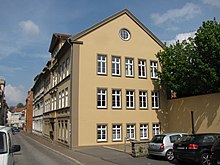
Golden Lion Memorial

Main gate of the Eisenach automobile plant
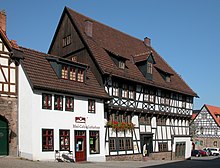
Luther House

Bach House and extension on Frauenplan house the Bach Museum

Convertible hall in the Kartaus garden

City Palace
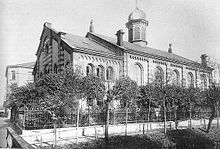
The synagogue in Eisenach around 1900
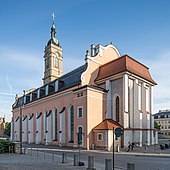
Church of St. George (Eisenach)
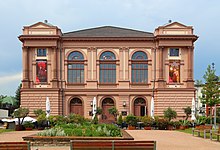
Thuringian State Theatre Eisenach
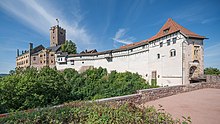
Landmark of the city: The Wartburg
Search within the encyclopedia